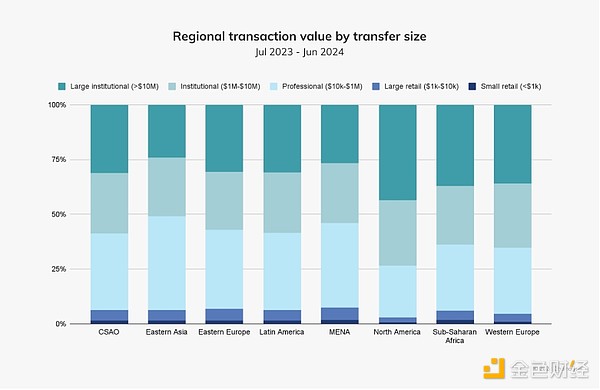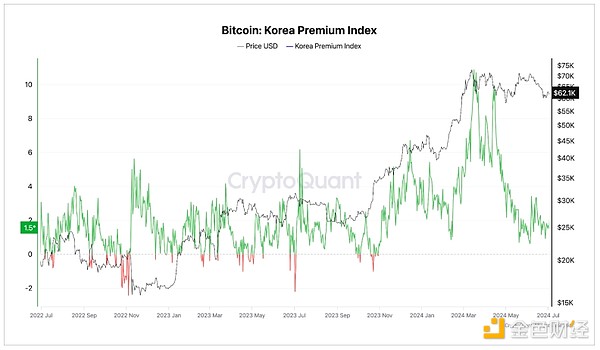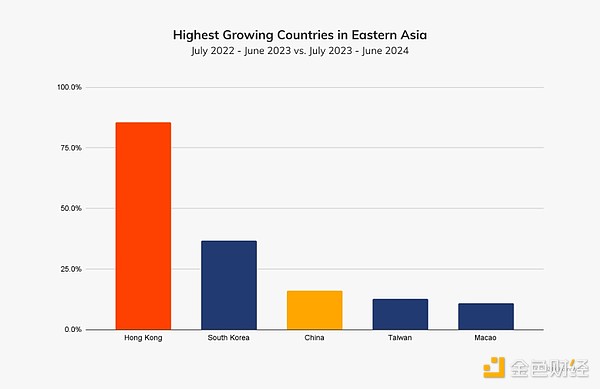Source: Chainalysis; Compiled by: Deng Tong, Golden Finance
East Asia is the sixth largest cryptocurrency economy in the world this year, accounting for 8.9% of the global value between July 2023 and June 2024. The region has garnered over $400 billion in on-chain value during the same period.

During the study period , East Asia’s cryptocurrency transaction value share remained relatively stable without significant fluctuations.

With this report Similar to all other regions,Centralized exchanges are the most popular service category in East Asia, accounting for 64.7% of cryptocurrency value.
East Asia’s share of cryptocurrency transaction value remained relatively stable without significant fluctuations during the study period.

With this report Similar to all other regions of p>Most of this activity is driven by large transfers from institutional and professional investors. Notably, East Asia accounts for the largest share of professional-scale transfers compared to any other region studied in this report.

Used by professional investors 's services are in stark contrast to those used by institutional investors. As shown below, professional investors primarily use centralized exchanges (CEX), while institutional investors use decentralized exchanges (DEX) and other decentralized services (DeFi). We speculate that institutional investors often seek investment strategies that exploit market inefficiencies; DEXs generally offer more arbitrage opportunities than CEXs due to their broader asset coverage.

East Asia accounts for five of the 50 regions with the highest cryptocurrency adoption rates in the world: South Korea (19), China (20), Japan (23) , Hong Kong (29) and Taiwan (40). Below, we take a closer look at the factors driving cryptocurrency adoption in these countries.
South Korea remains the largest market in East Asia
During the study period, South Korea leads the East Asia region in receiving approximately $130 billion worth of cryptocurrencies.

Since the first quarter of 2023, South Korea’s share of East Asia’s transaction volume has also grown steadily. We spoke to the head of one of South Korea’s top cryptocurrency exchanges, who speculated that several factors have contributed to this growth: “ Distrust of the traditional financial system has led investors to seek cryptocurrencies as alternative assets As large companies such as Samsung and the region strive to increase transparency and efficiency in their operations. With the adoption of blockchain, public perception of cryptocurrencies as a viable investment option has been further solidified. ”

A head of another Korean exchange provided us with more insights into these trends: "As a top IT country, South Korea through mobile applications Programs and PCs make it easy to trade digital assets. The general public has become increasingly interested in cryptocurrencies, especially after Bitcoin topped $70,000 in January 2024. “This rise in trading activity is evident in many places - more Specifically altcoins and stablecoins. Altcoins are the currency that South Koreans primarily use to trade against the Korean Won (KRW), making them more popular than any other crypto asset. Global exchanges had the highest outflows. The chart below shows that the increase in stablecoin outflows starting in December 2023 coincides with the listing of USDT on major Korean exchanges such as Coinone and Bithumb.

After altcoins , Bitcoin (BTC) is the second most traded cryptocurrency, alongside the South Korean won.

“Ripple has been very popular in South Korea since 2017, when it was expected to replace the SWIFT international money transfer system,”Page The heads of the two exchanges pointed out that he was referring to the International Information System for international payments and settlements. "We believe the reason for this popularity is that Ripple's transfer speed is very fast, about two seconds, and its unit price is relatively low compared to BTC and ETH."
In Real Trading Strategy On the other hand, Koreans appear to frequently use local exchanges to transfer funds to and from global exchanges, which offer diversified assets, arbitrage opportunities, margin and exit channels. The amount of funds moved from these local exchanges to global exchanges is highly correlated with the Korea Premium Index, indicating the existence of arbitrage opportunities.
The person in charge of the first exchange explained: “Kimchi premium refers to cryptocurrencies on the Korean market The phenomenon of higher prices than global markets. This is mainly because domestic demand in Korea is higher than the global market. Kimchi premiums fluctuate depending on market conditions and regulatory changes, making it a popular phenomenon among traders. span>” It’s worth noting that in March 2024, when Bitcoin hit an all-time high, the pickle premium surged.

The above pair of altcoins The strong interest and diverse trading opportunities bode well for South Korea’s future as a regional leader in cryptocurrency innovation. As we will explore later, this interest, along with supportive regulatory frameworks in other regions, may further accelerate cryptocurrency’s prominence in East Asia.
Hong Kong may ultimately influence China’s reopening of cryptocurrency markets
As we have explored in previous years , China’s relationship with cryptocurrencies has been tumultuous, characterized by multiple crackdowns and regulatory changes. Although the Chinese government was an early center for cryptocurrency mining and trading, it has imposed increasingly tight restrictions on unlicensed cryptocurrency activity due to concerns about financial stability, fraud, and capital flight. These actions resulted in widespread restrictions on cryptocurrency-related business activities in China in 2021 and undoubtedly contributed to a decline in overall cryptocurrency-related web traffic visits to exchange-related services from China starting in mid-2020.

Anyway, Hong Kong Having emerged as the crypto hub of Greater China, regulators’ openness to cryptocurrencies and decisiveness in developing regulatory frameworks has further fueled institutional adoption. Hong Kong is not an independent country but a special administrative region of China with a unique legal and regulatory framework. Its unique position allows it to be more flexible in promoting financial innovation, which is why we treat it separately from mainland China in this report.
Not surprisingly, Hong Kong has the highest year-over-year growth in East Asia at 85.6%, ranking 30th in the world in our Global Cryptocurrency Adoption Index.

Now, let’s go Take a look at some of the latest trends in China and Hong Kong.
Users look elsewhere
After the Chinese government shut down access to major cryptocurrency exchanges in 2021, users began to look elsewhere.

When we observe encryption The same pattern holds true when it comes to the relationship between currency OTC inflows and declines in the Shanghai Composite Index, a measure of stock trading on the Shanghai Stock Exchange.

Hong Kong’s support Regulatory framework drives institutional adoption
In June 2023, Hong Kong’s securities regulator implemented a new regulatory regime for virtual asset trading platforms (VATP). The regime provides retail investors with a regulated access to cryptocurrencies but also sets strict prudential, consumer protection and anti-money laundering/counter-terrorist financing standards. Over the past year, Hong Kong's regulators have been working hard to implement the new system.
May 31, 2024 marks the end of the transition period for this new regime, which means exchanges can only operate in Hong Kong if they are licensed or "deemed" to be licensed. The local branches of several popular exchanges withdrew their license applications before May 31 and thus had to stop providing trading services to Hong Kong residents. Given that their trading volumes have reached hundreds of millions of dollars since 2022, these developments could trigger a shift toward licensed or “deemed” exchanges, or an overall reduction in activity. As we can see below, the share of value captured by these exchanges has been steadily declining, with recent activity hovering around 10% to 15%.

Stablecoins occupy Hong Kong More than 40% of the total value each quarter; this is likely to grow as the Hong Kong Monetary Authority’s (HKMA) regulatory framework comes into effect, as regulated stablecoins will be allowed to be sold to retail investors in Hong Kong.

April 2024 On the 30th, Hong Kong’s financial regulator, the Securities and Futures Commission (SFC), approved three Bitcoin and three Ethereum-based spot Bitcoin ETFs to begin public trading. In the month leading up to this launch, we saw a significant increase in institutional Bitcoin transfers, many of which occurred on mainstream exchanges that partnered with institutional-facing businesses.

OSL is a leading Kevin Cui, CEO of Hong Kong-based digital asset trading platform that provides institutional-grade cryptocurrency trading services, explains how these ETFs are affecting the market. “As market conditions improve, we are seeing signs of growing institutional interest, which may lead to increased capital inflows in the near future. Not only do these ETFs provide a regulated avenue for investing in digital assets, but they also inspire Interest in holding BTC and ETH directly. This shift is significant as it marks a shift away from traditional financial instruments towards more direct participation in digital assets and reflects wider acceptance and understanding of their potential by the institutional investment community. ”< /p>
 JinseFinance
JinseFinance
 JinseFinance
JinseFinance JinseFinance
JinseFinance Clement
Clement Beincrypto
Beincrypto cryptopotato
cryptopotato Bitcoinist
Bitcoinist Bitcoinist
Bitcoinist Cointelegraph
Cointelegraph Cointelegraph
Cointelegraph Cointelegraph
Cointelegraph